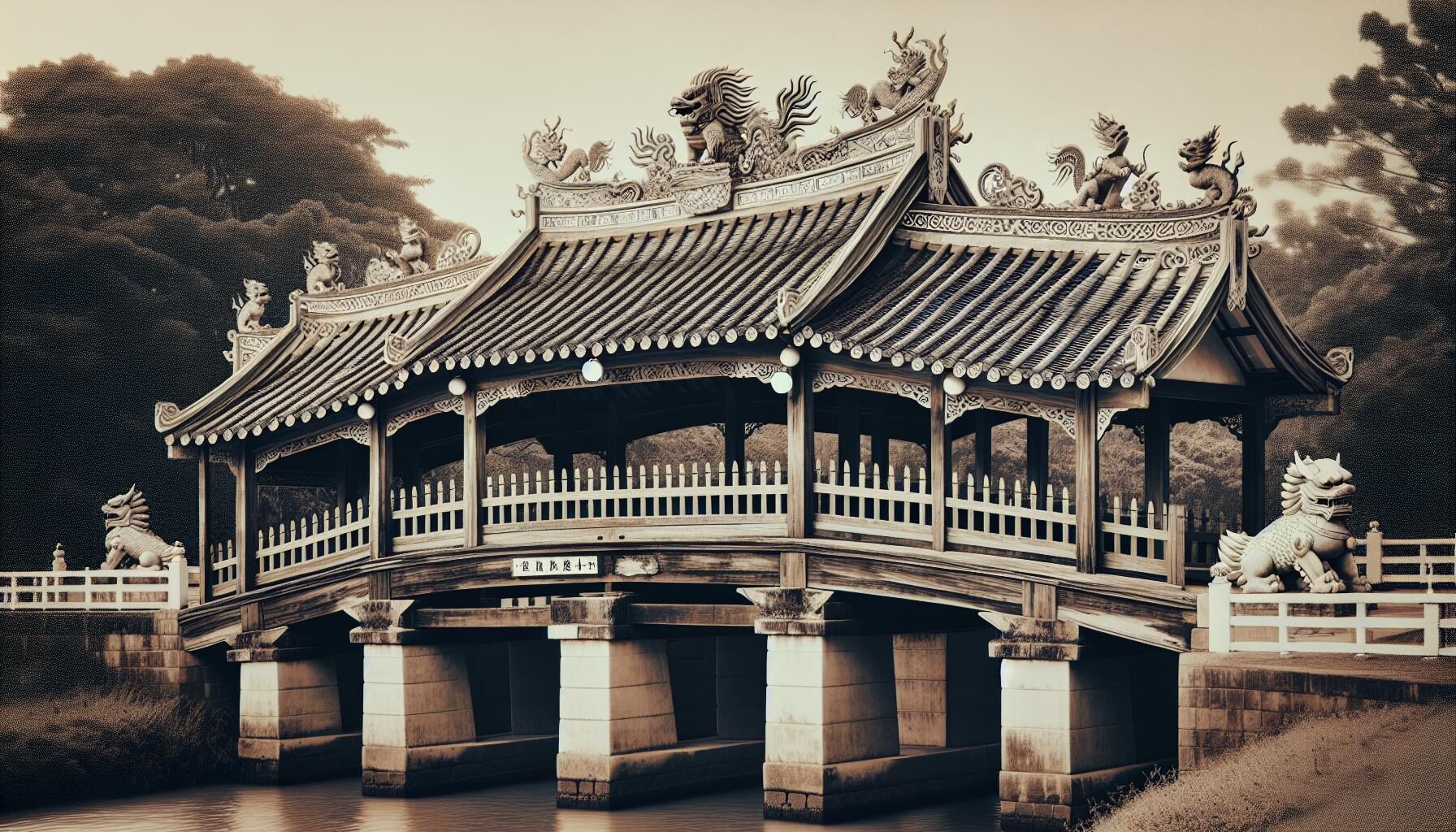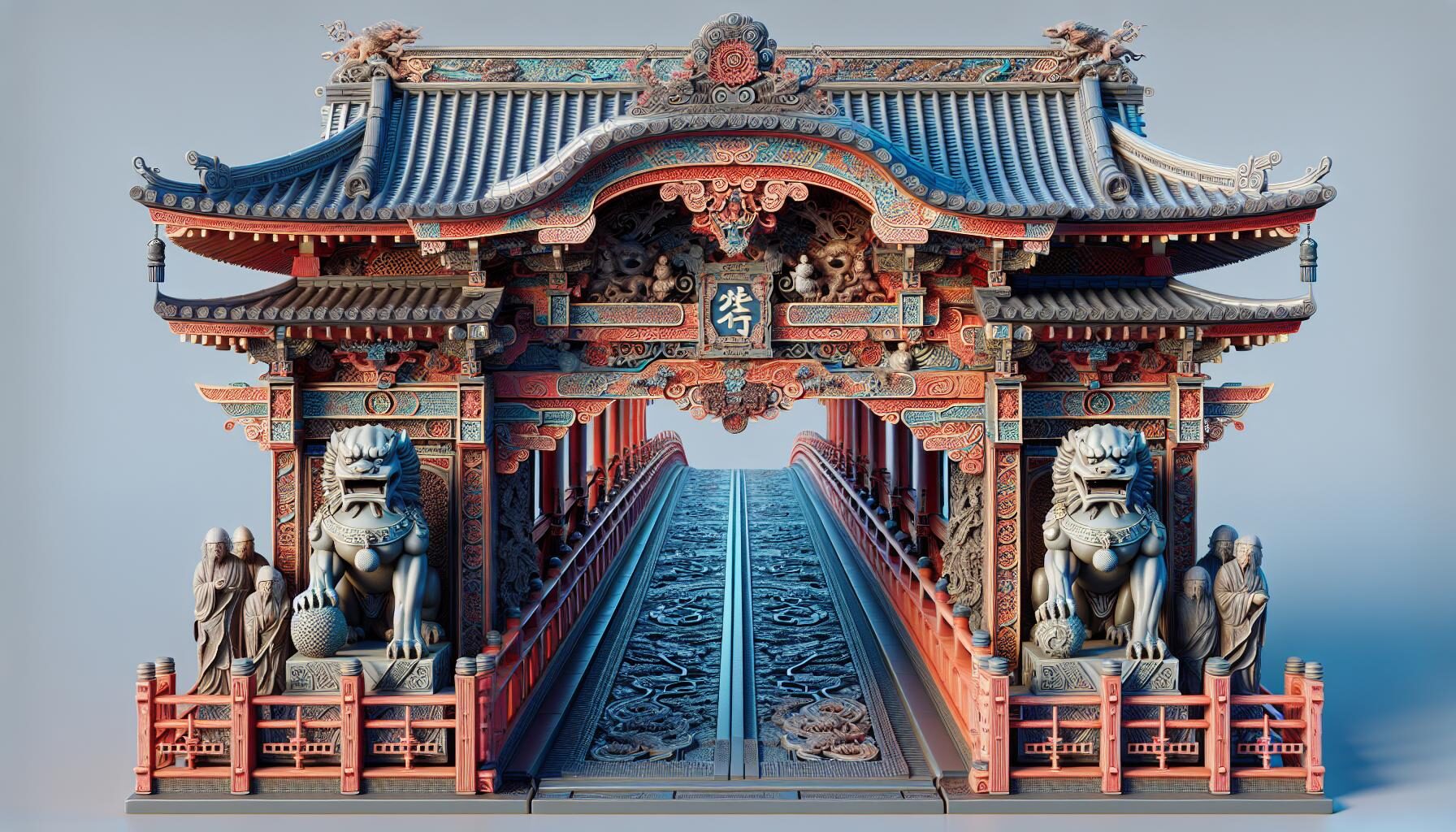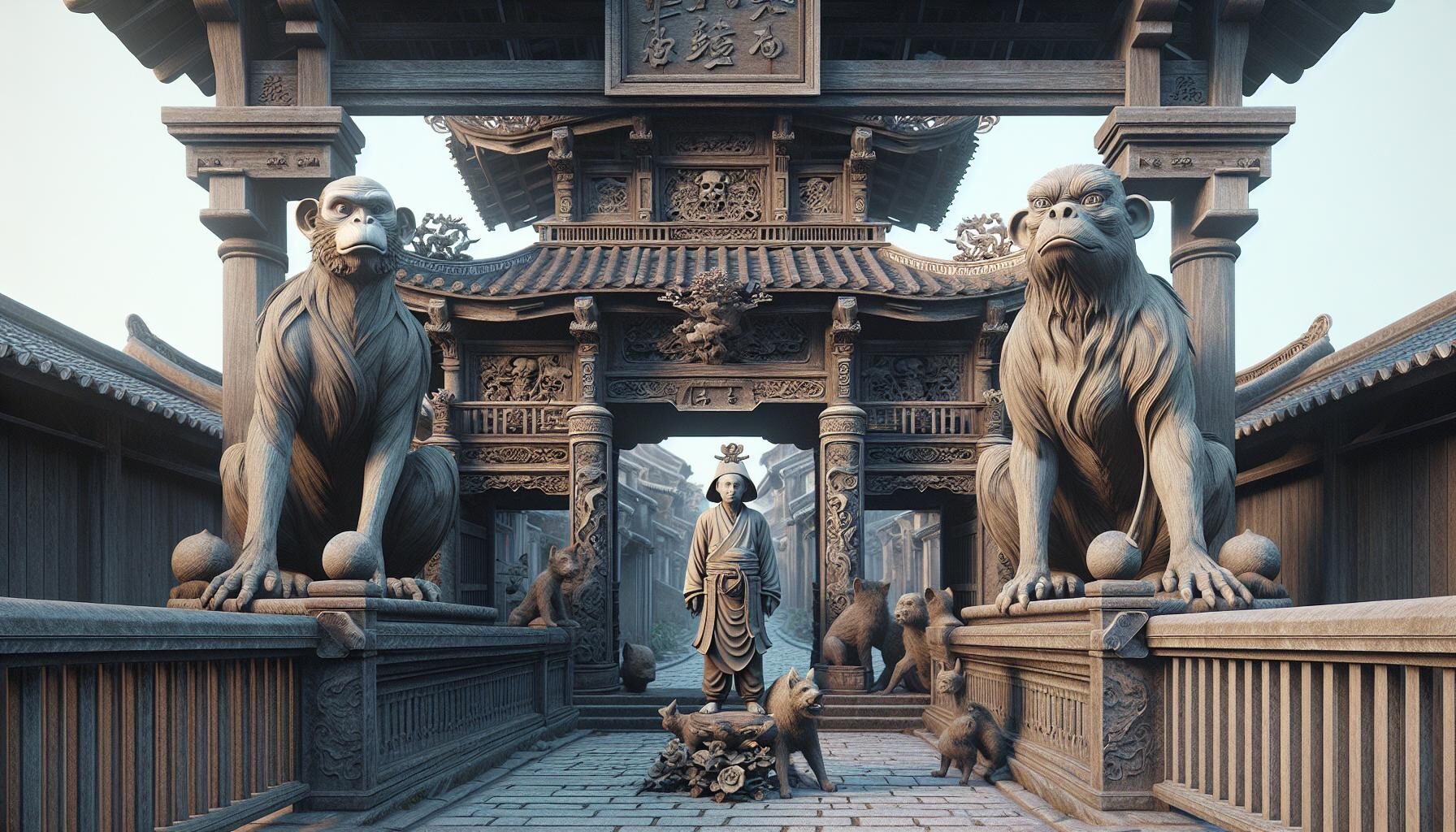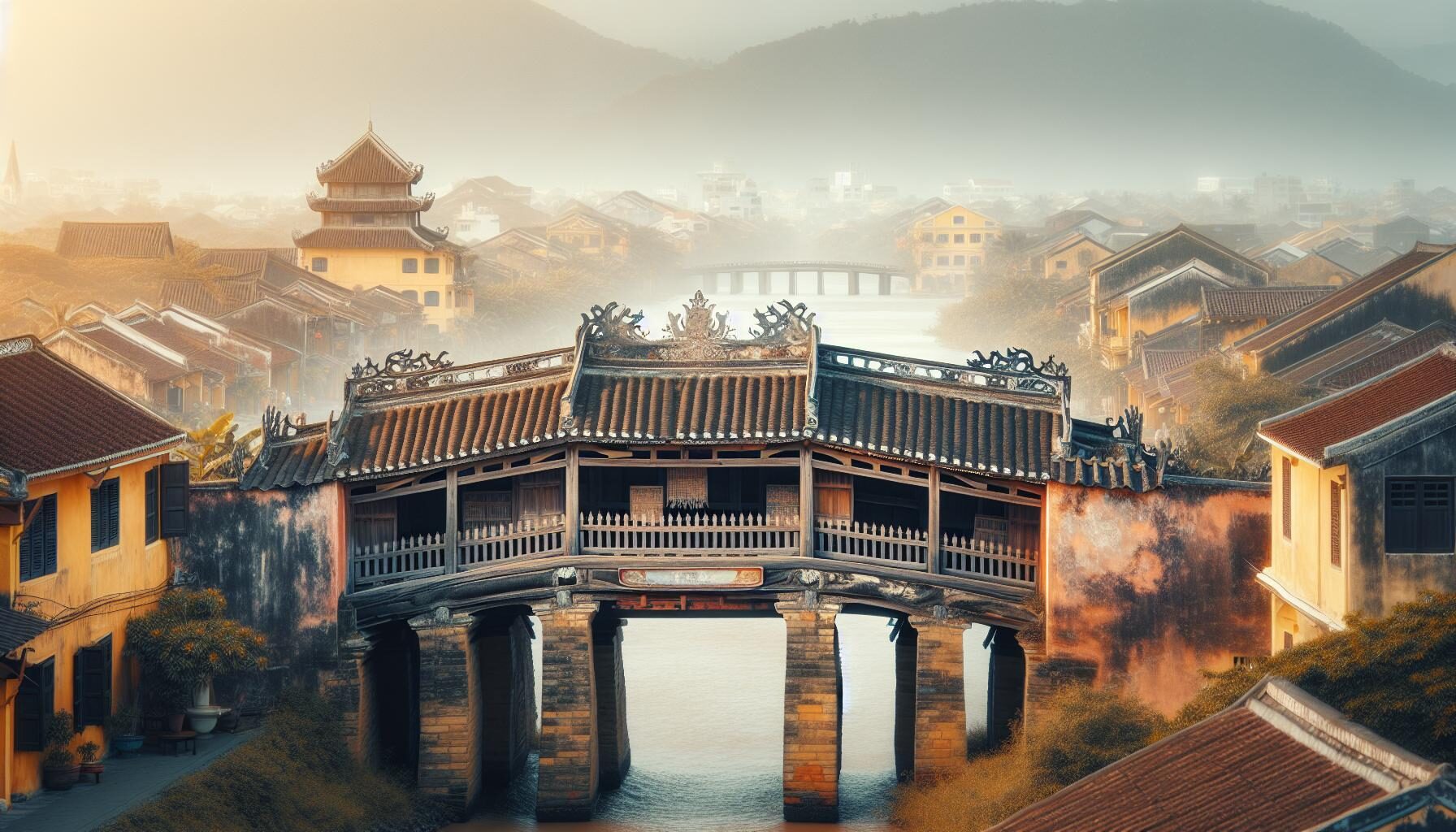Steeped in history and architectural splendor, the Japanese Covered Bridge in Hoi An is a sight we can’t get enough of. It’s a testament to the rich cultural fusion that has shaped this unique town.
This bridge isn’t just a path over water, it’s a symbolic passageway connecting cultures and time. It’s like stepping into a time machine, where every brick whispers tales of the past.
Join us as we delve into the fascinating story of this iconic landmark. We’re sure you’ll be just as captivated by its charm and significance as we are.
History of the Japanese Covered Bridge
Historical records trace the origins of the Japanese Covered Bridge back to the 1590s. Constructed by the Japanese community that resided in Hoi An, it’s undoubtedly an embodiment of dedication and remarkable craftsmanship from centuries ago. This stunning marvel of architecture was originally built to link the Japanese quarters to the Chinese quarters, serving as a symbolic gesture towards unity and harmony.
To understand the construction timeline of the Japanese Covered Bridge, we’ve put together a brief overview for easy reference:
| Century | Development |
|---|---|
| 16th | Initial construction of the bridge |
| 18th | Additional enhancements |
| 20th | Bridge repair and restoration |
Over the years, there have been minor enhancements and refurbishments on the bridge, ensuring its continued charm and strength. However, the most significant touch-ups took place in the 18th century, transforming it into the excellent state we see today.
The architecture of the Japanese Covered Bridge features a bright fusion of Japanese, Vietnamese, and Chinese styles. Notably, carvings and structures of dogs and monkeys grace both entrances, symbolizing the years when construction began and ended respectively, as per the Oriental zodiac. The weathered textures and hues of the bridge silently speak of the countless footsteps marked over the centuries, painting a vivid image of the past.
Far from being a mere passerby’s delight, the Japanese Covered Bridge indeed carries a wealth of history, one that unfolds a myriad of stories if we listen intently. Unveiling this magnificent historical monument, bit by bit, only accentuates its allure and the role it played in the cultural fusion of Hoi An.
Despite the passage of time, the Japanese Covered Bridge stands firm, simultaneously symbolizing resilience and cultural unity. It’s not just a footbridge but a compelling snapshot of Hoi An’s intriguing history. A visit here—which many call a trip back in time—is certainly an experience that remains etched in one’s memory.
Architectural Features

Stepping onto the Japanese Covered Bridge, we’re immediately drawn to the architectural elegance that defines this iconic landmark. With a construction timeline extending over three centuries, the bridge presents a unique blend of Japanese, Vietnamese, and Chinese architectural styles.
Looking closely, we’ll see the primary structure of the bridge is ingrained with classic Japanese design elements. There’s simplicity, minimalism, and the undeniable respect for natural materials. It’s the Japanese respect for nature that led to the choice of high-quality and durable local materials during initial construction.
Paying attention to the meticulously maintained bridge, we notice the Vietnamese influences. They’re particularly evident in the roof’s charm. Soaring high and curving upwards towards the sky, this feature depicts the distinct Vietnamese architectural approach of the 18th century.
Finally, we cannot miss the Chinese touches. These are significantly represented in the interior decorations and symbolic animal sculptures. The fusion is complete with the guardian statues of a monkey and a dog, which are considered sacred in the Chinese zodiac. These grand statues stand at both ends of the bridge, thoughtfully positioned to safeguard the crossing and its visitors.
Exploring further, we uncover that the bridge’s architectural design also boasts significant cultural relevance. Similarly, to a Japanese Torii gate, the Japanese Covered Bridge demarcates a sacred space and a worldly location. Thus, the bridge not only provides physical passage but also serves as a spiritual journey between two worlds.
The Japanese Covered Bridge is a true architectural marvel, a testament to the power of cultural fusion and historical preservation. Each structural feature narrates a captivating part of Hoi An’s rich history, making it more than a simple bridge. It stands as a tangible link to the past, an example of unity and resilience, and continues to be a symbol of Hoi An’s rich cultural heritage.
Symbolism and Cultural Significance

The Japanese Covered Bridge is more than just an architectural fusion – it’s highly symbolic. For starters, consider the guardian statues situated at each end of the bridge. These artistic carvings serve as protective deities according to both Japanese and Chinese folklore. On the side originating from Japan, we find a pair of monkey statues. Monkeys are seen as smart and protective creatures in many Asian cultures and their presence on the bridge symbolises safeguarding for all crossing the bridge. On the China-originating side, you’d see a pair of dog statues offering similar protective sentiments. The location of these statues is no coincidence – it’s directly tied to the time it took to construct the bridge. Folklore says it started in the year of the monkey and ended in the year of the dog.
The interior decoration and symbolic sculptures on the bridge are mostly of Chinese influence. Traditional ornate designs and the color red are Chinese elements we can identify that emphasizes good fortune and joy. Also, the layout of the bridge mirrors a Japanese Torii gate, signified by two upright posts and a crosspiece, marking the transition from the earthly to the sacred.
The overarching symbolism, however, is the bridge’s embodiment of a peaceful co-existence and mutual respect of diverse cultures. Hoi An once served as an essential port in Southeast Asia, and over the centuries, traders from various backgrounds left their mark in the city. The Japanese Covered Bridge stands as a clear testament to this eclectic mix of influences, not to mention a tangible link to the past. It is an iconic landmark that will forever signify a blend of cultures and histories – a symbol of unity and resilience in the fascinating city of Hoi An. This remarkable monument, thus, serves as a reminder to us all of the possibility of harmony amidst diversity.
Restoration Efforts
Over centuries of existence, the Japanese Covered Bridge has weathered natural and man-made calamities. It’s stood firm through typhoons, floods, and even the passage of war. Yet like any historical structure it periodically needs care, conservation, and yes, restoration. This old bridge, steeped in historical significance and cultural symbolism, continues to be a focal point of preservation efforts in Hoi An, defying the odds with its enduring resilience.
The bridge underwent a significant restoration process between 1986 and 1987. The authorities decided to proactively safeguard the bridge, keenly aware of its historical and cultural value. Vietnamese artisans played a crucial role in retaining the original look and feel of the bridge, using traditional methods and materials wherever possible.
- First, they repaired the bridge’s structural integrity, addressing areas weakened by time and the elements.
- Second, the decorative elements–the dog and monkey sculptures, the ornate interior details–were carefully cleaned and restored.
- Finally, the bridge was painted to match its original color–a vivid red symbolic of good fortune.
Concerns around the bridge’s preservation continue. Fluctuating water levels of the Thu Bon River, pollution, and the sheer volume of tourists crossing daily all present challenges. But Hoi An is committed to ongoing preservation. Regular maintenance and cautious restoration ensure the bridge withstands the test of time, remaining a cherished landmark for generations to come.
We understand that preserving a landmark like the Japanese Covered Bridge isn’t just about maintaining physical structures – it’s about safeguarding the profound symbolism and diverse cultural heritage it encapsulates. This is a tall order, one that Hoi An rises to constantly, keeping the bridge not only functional but a vibrant, living testament to the city’s rich history and multicultural past.
Visiting the Japanese Covered Bridge
When planning a trip to Hoi An, we must consider adding the Japanese Covered Bridge to our must-visit list. Here, we can interact with a living symbol of the city’s heritage and resilience.
As we step onto the antique wooden planks, we’re instantly hit with the essence of history that surrounds this architectural gem. Imagine, this bridge has withstood the test of time, bearing witness to the city’s evolution for more than four centuries. Subtly illuminated lanterns hanging from the ceiling enhance its mystical charm in the night. You can almost feel the stories of past generations whispering in your ear.
While wandering around, do remember to explore the small temple integrated within the bridge. The temple, dedicated to the Taoist God of weather, is an ideal place for those searching for a moment of quiet reflection amidst the city’s bustle.
Though touristy during peak hours, the best time to visit is either early morning or late evening. At these times, fewer people roam the ancient streets of Hoi An, allowing us to fully take in the beauty of the bridge.
For the enthusiastic photographers among us, the bridge, with its distinctive red color against the backdrop of emerald-green river, offers a picturesque view that can lead to stunning captures.
Do come prepared for fluctuating water levels under the bridge. The increasing water levels can sometimes limit access. Despite this, Hoi An is dedicated to maintaining the symbolic value of the bridge.
The Japanese Covered Bridge is not just a passage from one side of the water to the other. It’s a journey through time, culture, and historical resilience. As we cross this bridge, we’re participating in a practice that countless individuals have undertaken for centuries before us—the beauty of this thought is indeed overwhelming. As we venture deeper into Hoi An, the magic of this city continues to unfold.
Local Legends and Folklore

Our journey across the Japanese Covered Bridge would be incomplete without delving into the local legends and folklore that surroud this four-century-old symbol of Hoi An. The bridge’s tale is intertwined with the local culture offering visitors a spicy blend of truth, legend, and mythology.
First in our lore is the story of its construction. The bridge was built by the Japanese community in the early 17th century, hence its name. In the local language, though, it’s known as “Cau Chua Pagoda” translating to “Bridge for Worship”. It’s been rumored that the construction was intended to suppress the monster “Mamazu”. According to the folk, this beast had its head in India, tail in Japan, and the body rested in Hoi An. It was thought to cause earthquakes. The bridge’s location upon the monster’s back allegedly tamed the seismic activities.
Since then, we can’t attribute any earthquakes to the beast. So it’s either the monster’s been tamed or it’s simply an enchanting fable told through generations!
Another charmer is the tale of the dog and the monkey statues that guard the bridge. Constructed in the Year of the Monkey and completed in the Year of the Dog, sculptures of these animals have been installed at each end and remain focal points for both locals and visitors.
Not merely an architectural marvel, the bridge houses a small shrine of Tran Vo Bac De, the god believed to control all northern weather elements. Throughout the year, impressively, weather patterns seem to revolve around this temple’s rituals and observances.
Every legend adds a layer of intrigue to the bridge’s allure. And while we’ll never truly pull apart fact from fiction, these stories fortify the charm that makes this vibrant landmark a treasure trove for visitors. So next time, don’t just pass by; immerse yourself in the stories that breathe life into the Japanese Covered Bridge.
Future Preservation and Impact

Having withstood the test of time, the Japanese Covered Bridge continues to materialize as a cinematic blend of culture, history, and heritage. It remains a vivid testament of Hoi An’s evolutionary trajectory, connected to its past while continually adapting to the tides of the present. But propelling this iconic landmark into the future necessitates some notable undertakings on our part.
Conservation is core to keeping this historical structure vibrant. Our restoration efforts are driven by a two-fold objective: Using cutting-edge technology to fortify the structure while meticulously preserving its original design.
- Preservation: We’re relying on non-destructive techniques that don’t interfere with the bridge’s original structure yet ensure its integrity and safety. Techniques like infrared thermography are diligently employed to detect any internal flaws.
- Restoration: A team of specialized craftsmen and artisans refurbish damaged elements, ensuing the retention of the authentic architectural style which is inherent to its identity.
Moreover, the bridge’s role extends beyond the realm of history and architecture. It stands as a living legacy, continuing to shape our social and economic fabric.
- Tourism: The bridge consistently remains a major draw for tourists both domestically and internationally. It’s instrumental in contributing to local economy and promoting Hoi An as a top-tier cultural destination.
- Education: The bridge serves as a tangible source of education about our past, offering lessons in history, anthropology, architecture, and cultural studies. Schools, colleges, and researchers frequently visit the site for first-hand learning experiences.
- Community Impact: Our preservation efforts are expected to lead to increased local employment, improved public spaces, and a reinforced sense of community pride.
Preserving the Japanese Covered Bridge is not just about maintenance of a physical structure. It’s a shared commitment to upholding our heritage, celebrating our culture, and fortifying our community ties. Through diligent preservation, we’d be safeguarding this historic symbol, ensuring its resonance with future generations to come.
Conclusion
We’ve journeyed together through the rich history and captivating charm of the Japanese Covered Bridge in Hoi An. It’s more than just a bridge; it’s a symbol of unity, a beacon of the city’s resilience, and a testament to the power of preservation. As we’ve seen, the bridge’s allure lies not only in its physical beauty but also in the layers of local legends and folklore that surround it. The stories of the “Mamazu” monster and the dog and monkey guardians make it a vibrant landmark rich in mythology. The ongoing preservation efforts to maintain its original design while ensuring safety are a testament to the community’s commitment to their heritage. This iconic landmark plays a vital role in tourism, education, and community impact, strengthening ties for future generations. So whether you’re a history buff, a photography enthusiast, or a curious traveler, the Japanese Covered Bridge awaits to unfold its tales and charm.
What is the Japanese Covered Bridge?
The Japanese Covered Bridge is a historical structure located in Hoi An, Vietnam. It is known for its cultural value, unity symbolism, and harmonious design. Illuminated by lanterns at night, it comprises a temple and displays a rich red color against the river, with both charming and mystical features.
What is the best time to visit the Japanese Covered Bridge?
For a complete appreciation of its beauty, it’s preferable to visit the Japanese Covered Bridge in the early morning or late evening. This can also be an ideal time for photographers to capture its vibrant colors.
What are the legends and folklore surrounding the Japanese Covered Bridge?
There are several local legends and folklore surrounding the bridge, including a popular story about the construction of the bridge to suppress the monster known as “Mamazu”. The dog and monkey statues guarding the bridge also contribute to the intriguing mythology of the structure.
What are the ongoing preservation efforts for the Japanese Covered Bridge?
The ongoing preservation efforts include the use of advanced techniques to maintain the original design of the bridge while ensuring safety. These efforts aim not only to preserve the bridge’s history and architecture, but also to uphold heritage, celebrate culture, and strengthen community ties.